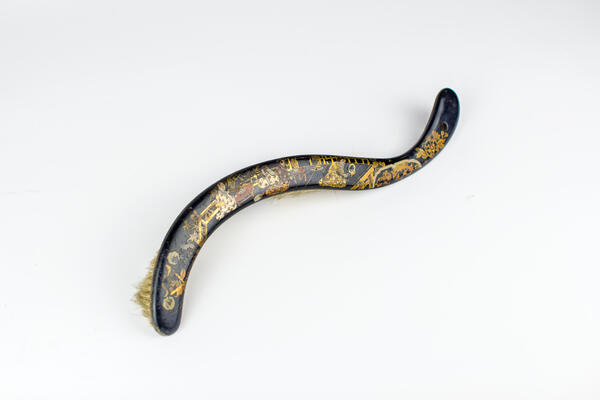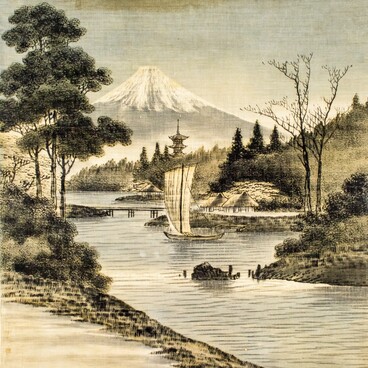A Japanese crumb brush is on display at the museum. Until 1917, it belonged to one of the local merchant families, but after nationalization, it was handed over to the museum, like many other items. The product depicts everyday scenes from the life of the Japanese.
Such kind of brush was used to sweep breadcrumbs from the table at the end of the meal before serving dessert. In the 18th century, it was not served to guests at dinner but was prepared after a meal in the living room, where everyone could take a portion. In the next century, the serving of dessert indicated the end of dinner. Before serving the sweet dish, it was common to change the dirty tablecloth or sweep crumbs away with a similar brush.
It is a known fact that even among the ancient Romans it was a custom to clean and sweep the table after a hot meal so thoroughly that not a single crumb was left.
The brush from the museum’s collection is decorated with traditional Japanese paintings called “kaiga”, which means “picture” or “drawing”. The most popular theme of Japanese art was nature, which was worshipped by the nation. Artists also depicted scenes from everyday life and thematic pictures with a large number of figures and miniature, finely drawn details on canvases and painted objects. One could see tea ceremonies, Kabuki Theater, sumo wrestlers, and other subjects on them. This tradition appeared in the early Middle Ages under the influence of Chinese painting, but over time it became an integral part of traditional Japanese art.
In the 18th century, woodcuts appeared. Images made by this technique were cheaper and more accessible than pieces of art created on parchment or canvas. The ordinary citizens decorated their houses with such paintings.
Since the second half of the 19th century, the art of Japan has been divided into opposing European and traditional styles. The government officially supported the Western style of painting. Promising young artists went abroad to study, and European masters came to Japan to develop a school program on art. However, after the initial surge of interest in Western art, there was a revival of the traditional Japanese style.
Such kind of brush was used to sweep breadcrumbs from the table at the end of the meal before serving dessert. In the 18th century, it was not served to guests at dinner but was prepared after a meal in the living room, where everyone could take a portion. In the next century, the serving of dessert indicated the end of dinner. Before serving the sweet dish, it was common to change the dirty tablecloth or sweep crumbs away with a similar brush.
It is a known fact that even among the ancient Romans it was a custom to clean and sweep the table after a hot meal so thoroughly that not a single crumb was left.
The brush from the museum’s collection is decorated with traditional Japanese paintings called “kaiga”, which means “picture” or “drawing”. The most popular theme of Japanese art was nature, which was worshipped by the nation. Artists also depicted scenes from everyday life and thematic pictures with a large number of figures and miniature, finely drawn details on canvases and painted objects. One could see tea ceremonies, Kabuki Theater, sumo wrestlers, and other subjects on them. This tradition appeared in the early Middle Ages under the influence of Chinese painting, but over time it became an integral part of traditional Japanese art.
In the 18th century, woodcuts appeared. Images made by this technique were cheaper and more accessible than pieces of art created on parchment or canvas. The ordinary citizens decorated their houses with such paintings.
Since the second half of the 19th century, the art of Japan has been divided into opposing European and traditional styles. The government officially supported the Western style of painting. Promising young artists went abroad to study, and European masters came to Japan to develop a school program on art. However, after the initial surge of interest in Western art, there was a revival of the traditional Japanese style.



